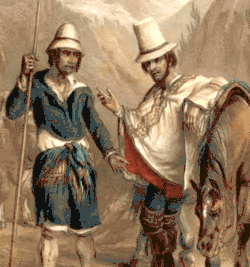Hat
A hat is a head covering which is worn for various reasons, including protection against weather conditions, ceremonial reasons such as university graduation, religious reasons, safety, or as a fashion accessory.[1]
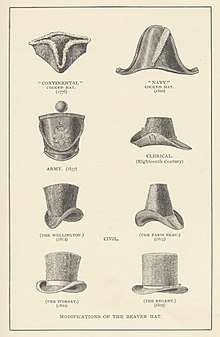
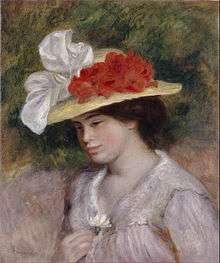
In the past, hats were an indicator of social status.[2] In the military, hats may denote nationality, branch of service, rank or regiment.[3] Police typically wear distinctive hats such as peaked caps or brimmed hats, such as those worn by the Royal Canadian Mounted Police. Some hats have a protective function. As examples, the hard hat protects construction workers' heads from injury by falling objects, a British police Custodian helmet protects the officer's head, a sun hat shades the face and shoulders from the sun, a cowboy hat protects against sun and rain and an ushanka fur hat with fold-down earflaps keeps the head and ears warm. Some hats are worn for ceremonial purposes, such as the mortarboard, which is worn (or carried) during university graduation ceremonies. Some hats are worn by members of a certain profession, such as the Toque worn by chefs. Some hats have religious functions, such as the mitres worn by Bishops and the turban worn by Sikhs.
History
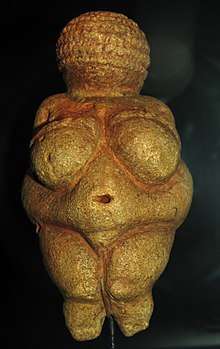
While there are not many official records of hats before 3,000 BC, they probably were commonplace before that. The 27,000-to-30,000-year-old Venus of Willendorf figurine may depict a woman wearing a woven hat.[4] One of the earliest known confirmed hats was worn by a Bronze Age man (nicknamed Ötzi) whose body (including his hat) was found frozen in a mountain between Austria and Italy, where he'd been since around 3250 BC. He was found wearing a bearskin cap with a chin strap, made of several hides stitched together, essentially resembling a Russian fur hat without the flaps.[5][6][7]
One of the first pictorial depictions of a hat appears in a tomb painting from Thebes, Egypt, which shows a man wearing a conical straw hat, dated to around 3200 BC. Hats were commonly worn in ancient Egypt. Many upper-class Egyptians shaved their heads, then covered it in a headdress intended to help them keep cool. Ancient Mesopotamians often wore conical hats or ones shaped somewhat like an inverted vase.
Other early hats include the Pileus, a simple skull-like cap; the Phrygian cap, worn by freed slaves in Greece and Rome (which became iconic in America during the Revolutionary War and the French Revolution, as a symbol of the struggle for liberty against the Monarchy); and the Greek petasos, the first known hat with a brim. Women wore veils, kerchiefs, hoods, caps and wimples.
Like Ötzi, the Tollund Man was preserved to the present day with a hat on, probably having died around 400 BC in a Danish bog, which mummified him. He wore a pointed cap made of sheepskin and wool, fastened under the chin by a hide thong.[8]
St. Clement, the patron saint of felt hatmakers, is said to have discovered felt when he filled his sandals with flax fibers to protect his feet, around 800 AD.[9]
In the Middle Ages, hats were a marker of social status and used to single out certain groups. The 1215 Fourth Council of the Lateran required that all Jews identify themselves by wearing the Judenhat ("Jewish hat"), marking them as targets for anti-Semitism.[10] The hats were usually yellow and were either pointed or square.[11]
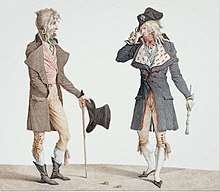
In the Middle Ages, hats for women ranged from simple scarves to elaborate hennin,[12] and denoted social status. Structured hats for women similar to those of male courtiers began to be worn in the late 16th century.[13] The term 'milliner' comes from the Italian city of Milan, where the best quality hats were made in the 18th century. Millinery was traditionally a woman's occupation, with the milliner not only creating hats and bonnets but also choosing lace, trimmings and accessories to complete an outfit.[14]
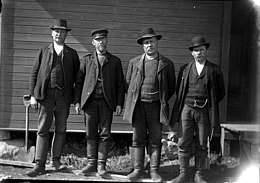
In the first half of the 19th century, women wore bonnets that gradually became larger, decorated with ribbons, flowers, feathers, and gauze trims. By the end of the century, many other styles were introduced, among them hats with wide brims and flat crowns, the flower pot and the toque. By the middle of the 1920s, when women began to cut their hair short, they chose hats that hugged the head like a helmet.[13]
The tradition of wearing hats to horse racing events began at the Royal Ascot in Britain, which maintains a strict dress code. All guests in the Royal Enclosure must wear hats.[15] This tradition was adopted at other horse racing events, such as the Kentucky Derby in the United States.[16]
Extravagant hats were popular in the 1980s, and in the early 21st century, flamboyant hats made a comeback, with a new wave of competitive young milliners designing creations that include turban caps, trompe-l'oeil-effect felt hats and tall headpieces made of human hair. Some new hat collections have been described as "wearable sculpture". Many pop stars, among them Lady Gaga, have commissioned hats as publicity stunts.[17]
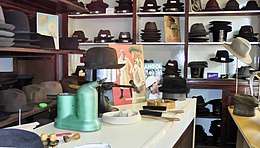
Famous hatmakers
One of the most famous London hatters is James Lock & Co. of St James's Street.[18] The shop claims to be the oldest operating hat shop in the world.[19] Another was Sharp & Davis of 6 Fish Street Hill.[20] In the late 20th century, museums credited London-based David Shilling with reinventing hats worldwide. Notable Belgian hat designers are Elvis Pompilio and Fabienne Delvigne (Royal warrant of appointment holder), whose hats are worn by European royals.[21] Philip Treacy OBE is an award-winning Irish milliner whose hats have been commissioned by top designers[22] and worn at royal weddings.[23] In North America, the well-known cowboy-hat manufacturer Stetson made the headgear for the Royal Canadian Mounted Police and the Texas Rangers.[24] John Cavanagh was one of the notable American hatters.[25] Italian hat maker Borsalino has covered the heads of Hollywood stars and the world's rich and famous.[26]
Collections
The Philippi Collection is a collection of religious headgear assembled by a German entrepreneur, Dieter Philippi, located in Kirkel.[27] The collection features over 500 hats,[28] and is currently the world's largest collection of clerical, ecclesiastical and religious head coverings.[29]
Styles
This is a short list of some common and iconic examples of hats. There is a longer version at List of hat styles.
| Image | Name | Description |
|---|---|---|
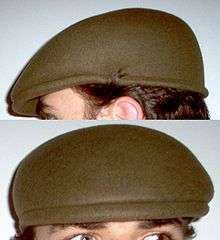 |
Ascot cap | A hard men's cap, similar to the flat cap, but distinguished by its hardness and rounded shape. |
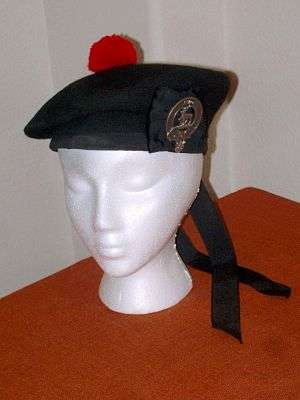 |
Balmoral bonnet | Traditional Scottish bonnet or cap worn with Scottish Highland dress. |
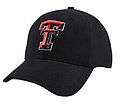 |
Baseball cap | A type of soft, light cotton cap with a rounded crown and a stiff, frontward-projecting brim. |
| Beanie | A brimless cap, with or without a small visor, once popular among school boys. Sometimes includes a propeller. Note: In New Zealand, Australia, the United States and the United Kingdom, "beanie" also or otherwise refers to the tuque. | |
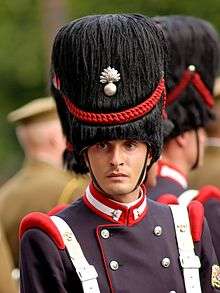 |
Bearskin | The tall, furry hat of the Brigade of Guards' full-dress uniform, originally designed to protect them against sword-cuts, etc. Commonly seen at Buckingham Palace in London, England. Sometimes mistakenly identified as a busby. |
| Beret | A soft round cap, usually of woollen felt, with a bulging flat crown and tight-fitting brimless headband. Worn by both men and women and traditionally associated with Basque people, France, and the military. Often part of [European?] schoolgirls' uniform during the 1920s, '30s and '40s. | |
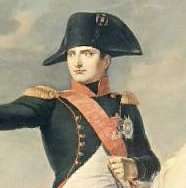 |
Bicorne | A broad-brimmed felt hat with brim folded up and pinned front and back to create a long-horned shape. Also known as a cocked hat. Worn by European military officers in the 1790s and, as illustrated, commonly associated with Napoleon. |
 |
Bowler / Derby | A hard felt hat with a rounded crown created in 1850 by Lock's of St James's, the hatters to Thomas Coke, 2nd Earl of Leicester, for his servants. More commonly known as a Derby in the United States. |
| Buntal | A traditional straw hat from the Philippines woven from fibers extracted from buri palms. | |
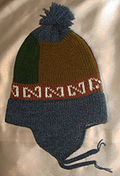 |
Chullo | Peruvian or Bolivian hat with ear-flaps made from vicuña, alpaca, llama or sheep's wool.[30] |
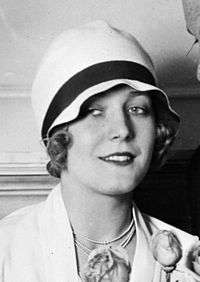 |
Cloche hat | A bell-shaped ladies' hat that was popular during the Roaring Twenties. |
 |
Cricket cap | A type of soft cap traditionally worn by cricket players. |
| Sombrero Cordobés | A traditional flat-brimmed and flat-topped hat originating from Córdoba, Spain, associated with flamenco dancing and music and popularized by characters such as Zorro. | |
 |
Conical Asian hat | A conical straw hat associated with East and Southeast Asia. Sometimes known as a "coolie hat", although the term "coolie" may be interpreted as derogatory.[31][32] |
.jpg) |
Coonskin cap | A hat, fashioned from the skin and fur of a raccoon, that became associated with Canadian and American frontiersmen of the 18th and 19th centuries. |
 |
Custodian helmet | A helmet traditionally worn by British police constables while on foot patrol. |
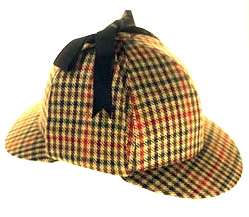 |
Deerstalker | A warm, close-fitting tweed cap, with brims front and behind and ear-flaps that can be tied together either over the crown or under the chin. Originally designed for use while hunting in the climate of Scotland. Worn by –and so closely associated with – the character Sherlock Holmes. |
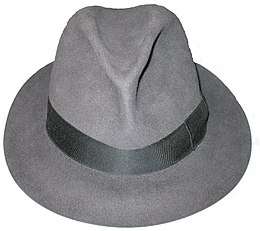 |
Fedora | A soft felt hat with a medium brim and lengthwise crease in the crown. |
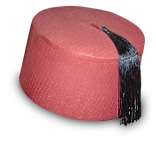 |
Fez | Red felt hat in the shape of a truncated cone, common to Arab-speaking countries. |
| Fulani hat | A conical plant fiber hat covered in leather both at the brim and top, worn by men of the Fulani people in West Africa. | |
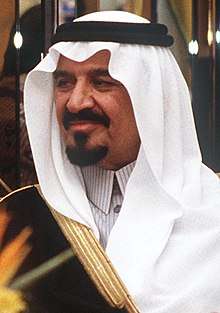 |
Keffiyah | Three piece ensemble consisting of a Thagiyah skull cap, Gutrah scarf, and Ogal black band. Gutrahs are plain white or checkered, denoting ethnic or national identities.. |
| Hard hat | A rounded rigid helmet with a small brim predominantly used in workplace environments, such as construction sites, to protect the head from injury by falling objects, debris and bad weather. | |
| Kippah | A hemispherical cap worn by Jews to fulfill the customary requirement held by halachic authorities that the head be covered at all times. | |
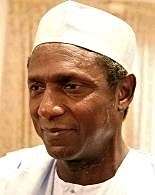 |
Kufi | A brimless, short, rounded cap worn by Africans and people throughout the African diaspora. |
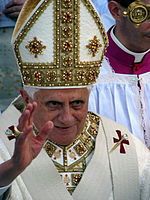 |
Mitre | Distinctive hat worn by bishops in the Roman Catholic Church, Eastern Orthodox Church, and the Anglican Communion. |
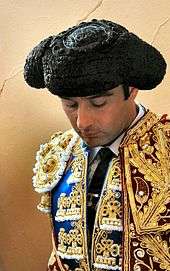 |
Montera | A crocheted hat worn by bullfighters. |
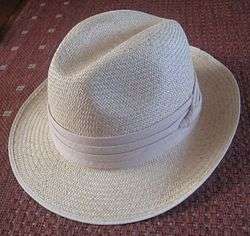 |
Panama | Straw hat made in Ecuador. |
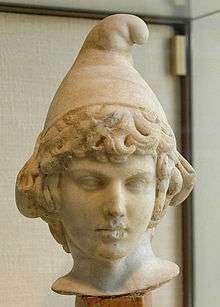 |
Phrygian Cap | A soft conical cap pulled forward. In sculpture, paintings and caricatures it represents freedom and the pursuit of liberty. The popular cartoon characters The Smurfs wear white Phrygian caps. |
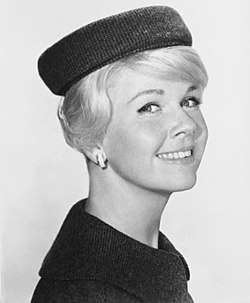 |
Pillbox hat | A small hat with straight, upright sides, a flat crown, and no brim. |
| Pith Helmet | A lightweight rigid cloth-covered helmet made of cork or pith, with brims front and back. Worn by Europeans in tropical colonies in the 1800s. | |
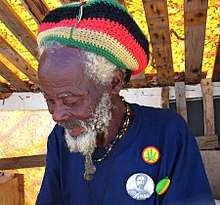 |
Rastacap | A tall, round, usually crocheted and brightly colored, cap worn by Rastafarians and others with dreadlocks to tuck their locks away. |
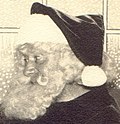 |
Santa Hat | A floppy pointed red hat trimmed in white fur traditionally associated with Christmas. |
| Sombrero | A Mexican hat with a conical crown and a very wide, saucer-shaped brim, highly embroidered made of plush felt. | |
| Stetson | Also known as a "Cowboy Hat". A high-crowned, wide-brimmed hat, with a sweatband on the inside, and a decorative hat band on the outside. Customized by creasing the crown and rolling the brim.[33] | |
| Tam o'Shanter | A traditional flat, round Scottish cap usually worn by men (in the British military sometimes abbreviated ToS). | |
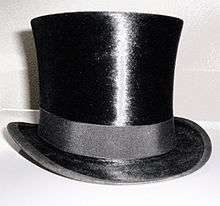 |
Top hat | Also known as a beaver hat, a magician's hat, or, in the case of the tallest examples, a stovepipe hat. A tall, flat-crowned, cylindrical hat worn by men in the 19th and early 20th centuries, now worn only with morning dress or evening dress. Cartoon characters Uncle Sam and Mr. Monopoly are often depicted wearing such hats. Once made from felted beaver fur. |
| Toque | (informally, "chef's hat") A tall, pleated, brimless, cylindrical hat traditionally worn by chefs. | |
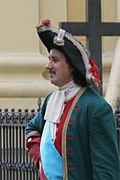 |
Tricorne | A soft hat with a low crown and broad brim, pinned up on either side of the head and at the back, producing a triangular shape. Worn by Europeans in the 18th century. Larger, taller, and heavily ornamented brims were present in France and the Papal States. |
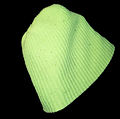 |
Tuque | In Canada, a knitted hat, worn in winter, usually made from wool or acrylic. Also known as a ski cap, knit hat, knit cap, sock cap, stocking cap, toboggan, watch cap, or goobalini. In New Zealand, Australia, the United States and the United Kingdom, the term "beanie" is applied to this cap. |
| Turban | A headdress consisting of a scarf-like single piece of cloth wound around either the head itself or an inner hat. | |
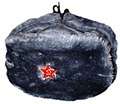 |
Ushanka | A Russian fur hat with fold-down ear-flaps. |
 |
Zucchetto | Skullcap worn by clerics, typically in Roman Catholicism. |
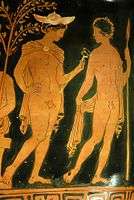
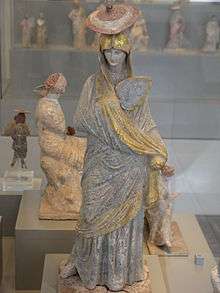 Ancient Greek statue of a lady with blue and gilt garment, a fan and a sun hat, from Tanagra, c. 325–300 BC.
Ancient Greek statue of a lady with blue and gilt garment, a fan and a sun hat, from Tanagra, c. 325–300 BC.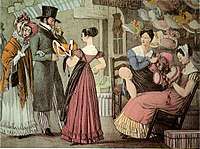
- Hat fashions have sometimes been the subject of ridicule. This 1908 cartoon by Ion Theodorescu-Sion, which first appeared in a Romanian publication, satirised the popularity of mushroom hats.
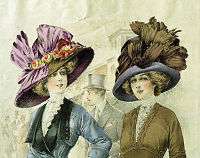 Women's picture hats from 1911.
Women's picture hats from 1911.- New York City, 1918: A large crowd of people, almost all wearing hats.
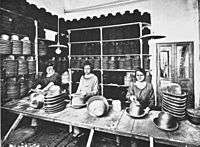 Family-owned hat factory in Montevarchi, Italy, date unknown.
Family-owned hat factory in Montevarchi, Italy, date unknown.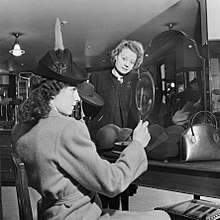 Millinery department of Bourne & Hollingsworth, in London's Oxford Street in 1942. Unlike most other clothing, hats were not strictly rationed in wartime Britain and there was an explosion of adventurous millinery styles.
Millinery department of Bourne & Hollingsworth, in London's Oxford Street in 1942. Unlike most other clothing, hats were not strictly rationed in wartime Britain and there was an explosion of adventurous millinery styles.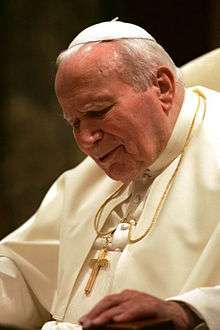 John Paul II wearing a zuchetto.
John Paul II wearing a zuchetto.
Size
Hat sizes are determined by measuring the circumference of a person's head about 1 centimetre (1⁄2 in) above the ears. Inches or centimeters may be used depending on the manufacturer. Felt hats can be stretched for a custom fit. Some hats, like hard hats and baseball caps, are adjustable. Cheaper hats come in "standard sizes", such as small, medium, large, extra large: the mapping of measured size to the various "standard sizes" varies from maker to maker and style to style, as can be seen by studying various catalogues, such as Hammacher Schlemmer.[34]
| size | Youth S/M | Youth L/XL | XXS | XS | S | M | L | XL | XXL | XXXL | ||||
|---|---|---|---|---|---|---|---|---|---|---|---|---|---|---|
| Age (years) | 0 | 1⁄2 | 1 | 1 1⁄2 | 2 | |||||||||
| Circumference in cm | 34 | 43 | 47 | 48 | 49 | 50 | 51–52 | 53–54 | 55–56 | 57–58 | 59–60 | 61–62 | 63–64 | 65–66 |
| Circumference in inches | 13 3⁄8 | 17 | 18 1⁄2 | 18 3⁄4 | 19 1⁄4 | 19 3⁄4 | 20 1⁄8–20 1⁄2 | 20 5⁄8–21 1⁄4 | 21 5⁄8–22 | 221⁄2–227⁄8 | 231⁄4–235⁄8 | 24–243⁄8 | 243⁄4–251⁄4 | 25–26 |
| UK hat size | 5 | 53⁄4 | 6–61⁄8 | 61⁄4–63⁄8 | 61⁄2–65⁄8 | 63⁄4–67⁄8 | 7–71⁄8 | 71⁄4–73⁄8 | 71⁄2–75⁄8 | 73⁄4–77⁄8 | 8–81⁄8 | |||
| US hat size | 57⁄8 | 6 | 61⁄8 | 61⁄4 | 6–61⁄2 | 65⁄8–63⁄4 | 67⁄8–7 | 71⁄8–71⁄4 | 73⁄8–71⁄2 | 75⁄8–73⁄4 | 77⁄8–8 | 81⁄8–81⁄4 | ||
| French hat size | 0 | 1⁄2 | 1 | 11⁄2 | 2–21⁄2 | 3–31⁄2 | 4–41⁄2 | 5–51⁄2 | 6–61⁄2 | 7–71⁄2 | 8–81⁄2 | 9–91⁄2 |
References
- Pauline Thomas (2007-09-08). "The Wearing of Hats Fashion History". Fashion-era.com. Retrieved 2011-07-02.
- "The social meanings of hats". University of Chicago Press. Retrieved 2011-07-02.
- "Insignia:The Way You Tell Who's Who in the Military". United States Department of Defense. Archived from the original on 2012-04-14. Retrieved 2011-07-02.
- "BBC News | SCI/TECH | World's oldest hat revealed". news.bbc.co.uk. Retrieved 2018-09-25.
- Davis, Nicola (30 August 2016). "It becometh the iceman: clothing study reveals stylish secrets of leather-loving ancient". The Guardian. Archived from the original on 30 August 2016. Retrieved 30 August 2016.
- Romey, Kristin (18 August 2016). "Here's What the Iceman Was Wearing When He Died 5,300 Years Ago". National Geographic. Archived from the original on 19 August 2016. Retrieved 18 August 2016.
- O’Sullivan, Niall J.; Teasdale, Matthew D.; Mattiangeli, Valeria; Maixner, Frank; Pinhasi, Ron; Bradley, Daniel G.; Zink, Albert (18 August 2016). "A whole mitochondria analysis of the Tyrolean Iceman's leather provides insights into the animal sources of Copper Age clothing". Scientific Reports. 6: 31279. doi:10.1038/srep31279. ISSN 2045-2322. PMC 4989873. PMID 27537861.
- "The Tollund Man – Appearance". The Tollund Man – A face from prehistoric Denmark. 2004. Archived from the original on 2011-07-19. Retrieved 2016-09-30.
- "History of Hats". Hatsandcaps.co.uk. Retrieved 2011-07-02.
- Waldman, Katy (2013-10-17). "The history of the witch's hat". Slate.com. Retrieved 2014-03-26.
- Johnston, Ruth A. (2011). All Things Medieval: An Encyclopedia of the Medieval World. ABC-CLIO. Retrieved 2014-03-26.
- Vibbert, Marie, Headdresses of the 14th and 15th Centuries, No. 133, SCA monograph series (August 2006)
- "Hat history". Hatsuk.com. Archived from the original on 2000-09-14. Retrieved 2012-01-07.
- "History of Women's Hats". Vintagefashionguild.org. Retrieved 2012-01-07.
- Lauren Turner (2012-06-21). "New dress code a hit at Ascots' Ladies Day". Independent.co.uk. Retrieved 2013-08-29.
- "Hats in History: The Kentucky Derby". Hats-plus.com. 2012-04-28. Retrieved 2013-08-29.
- Millinery Madness: Hat Makers With Attitude
- See Whitbourn, F.: 'Mr Lock of St James's St Heinemann, 1971.
- Centuries of hats
- For an account of the Sharp family's hat-making business, see Knapman, D. – 'Conversation Sharp – The Biography of a London Gentleman, Richard Sharp (1759–1835), in Letters, Prose and Verse'. [Private Publication, 2004]. British Library.
- "Brussels life". Brusselslife.be. Retrieved 2013-04-15.
- "Philip Treacy 'Hatforms' at IMMA Thursday". Raidió Teilifís Éireann. 5 April 2001. Archived from the original on August 17, 2012. Retrieved 11 December 2010.
- Philip Treacy: King of Royal wedding hats Irish Independent, 2011-04-29
- Snyder, Jeffrey B. (1997). Stetson Hats and the John B. Stetson Company 1865–1970. Atglen: Schiffer. p. 57. ISBN 0-7643-0211-6.
- "Cavanagh Hats". Bernard Hats. Retrieved 2019-12-06.
- Hats and Headwear around the World: A Cultural Encyclopedia:, Beverly Chico, ABC-CLIO, 03.10.2013, P. 155
- "Neue Zürcher Zeitung FOLIO". Nzzfolio.ch. 2011-02-08. Retrieved 2012-01-07.
- "Der Spiegel". Spiegel.de. Retrieved 2012-01-07.
- "Philippi Collection". Philippi-collection.blogspot.com. 2011-11-23. Retrieved 2012-01-07.
- Klinkenborg, Verlyn (2009-02-03). "Season of the chullo". International Herald Tribune. Archived from the original on January 30, 2009. Retrieved 2011-07-02.
- Location Settings (2011-10-20). "Malema under fire over slur on Indians". News24. Retrieved 2013-06-16.
- Most current dictionaries do not record any offensive meaning ("an unskilled laborer or porter usually in or from India hired for low or subsistence wages" Merriam-Webster) or make a distinction between an offensive meaning in referring to "a person from the Indian subcontinent or of Indian descent" and an at least originally inoffensive, old-fashioned meaning, for example "dated an unskilled native labourer in India, China, and some other Asian countries" (Compact Oxford English Dictionary). However, some dictionaries indicate that the word may be considered offensive in all contexts today. For example, Longman Archived 2006-11-27 at the Wayback Machine's 1995 edition had "old-fashioned an unskilled worker who is paid very low wages, especially in parts of Asia", but the current version adds "taboo old-fashioned a very offensive word ... Do not use this word".
- Snyder, Jeffrey B. (1997). Stetson Hats and the John B. Stetson Company 1865–1970. Atglen: Schiffer. p. 5. ISBN 0-7643-0211-6.
- "Helmet sizes". Enduroworld.com.au. Archived from the original on March 25, 2012.
External links



